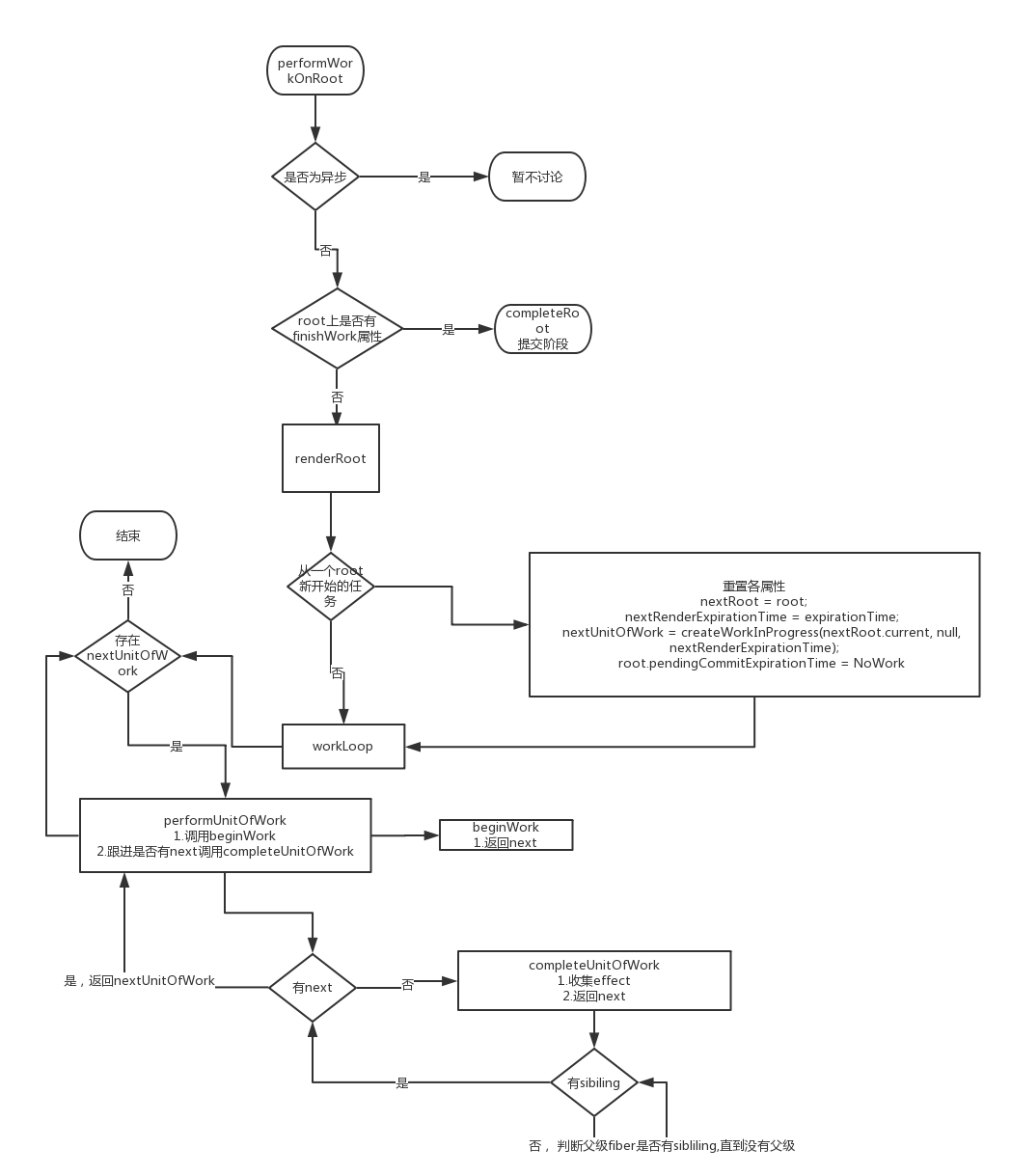系列文章
React Fiber源码分析 第一篇
React Fiber源码分析 第二篇(同步模式)
React Fiber源码分析 第三篇(异步状态)
React Fiber源码分析 第四篇(归纳总结)
前言
React Fiber是React在V16版本中的大更新,利用了闲余时间看了一些源码,做个小记录~
如果有错误,请轻喷
流程图
流程图1

流程图2

源码分析
1.scheduleRootUpdate这个函数主要执行了两个操作 1个是创建更新createUpdate并放到更新队列enqueueUpdate, 1个是执行sheculeWork函数
function scheduleRootUpdate(current$$1, element, expirationTime, callback) {
var update = createUpdate(expirationTime);
update.payload = { element: element };
callback = callback === undefined ? null : callback;
if (callback !== null) {
update.callback = callback;
}
enqueueUpdate(current$$1, update);
scheduleWork(current$$1, expirationTime);
return expirationTime;
}2.先从createUpdate函数分析, 他直接返回了一个包含了更新信息的对象
function createUpdate(expirationTime) {
return {
// 优先级
expirationTime: expirationTime,
// 更新类型
tag: UpdateState,
// 更新的对象
payload: null,
callback: null,
// 指向下一个更新
next: null,
// 指向下一个更新effect
nextEffect: null
};
}3.接着更新payload和callback属性, payload即为更新的对象, 然后执行enqueuUpdate, enqueueUpdate相对比较容易理解, 不过里面有一注释挺重要
Both queues are non-empty. The last update is the same in both lists, because of structural sharing. So, only append to one of the lists 意思是alternate的updateQueue和fiber的updateQueue是同一个对象引用,这里会在createWorkInProcess提到
往下走就是重要的scheduleWork, 它是render阶段真正的开始
function scheduleWork(fiber, expirationTime) {
// 更新优先级
var root = scheduleWorkToRoot(fiber, expirationTime);
...if (!isWorking && nextRenderExpirationTime !== NoWork && expirationTime < nextRenderExpirationTime) {
// This is an interruption. (Used for performance tracking.) 如果这是一个打断原有更新的任务, 先把现有任务记录
interruptedBy = fiber;
resetStack();
}
// 设置下一个操作时间nextExpirationTimeToWorkOn
markPendingPriorityLevel(root, expirationTime);
if (
// If we're in the render phase, we don't need to schedule this root
// for an update, because we'll do it before we exit...
!isWorking || isCommitting$1 ||
// ...unless this is a different root than the one we're rendering.
nextRoot !== root) {
var rootExpirationTime = root.expirationTime;
requestWork(root, rootExpirationTime);
}
...
}4.scheduleWork先执行一个scheduleWorkToRoot函数, 该函数主要是更新其expirationTime以及上层fiber的childrenExpirationTime
function scheduleWorkToRoot(fiber, expirationTime) {
// Update the source fiber's expiration time
if (fiber.expirationTime === NoWork || fiber.expirationTime > expirationTime) {
fiber.expirationTime = expirationTime;
}
var alternate = fiber.alternate;
if (alternate !== null && (alternate.expirationTime === NoWork || alternate.expirationTime > expirationTime)) {
alternate.expirationTime = expirationTime;
}
// 如果是HostRoot 即直接返回
var node = fiber.return;
if (node === null && fiber.tag === HostRoot) {
return fiber.stateNode;
}
// 若子fiber中有更新, 即更新其childrenExpirationTime
while (node !== null) {
...
}
return null;
}5.接着会执行一个markPendingPriorityLevel函数,这个函数主要是更新root的最高优先级和最低优先级(earliestPendingTime和lastestPendingTime;), 同时设置下一个执行操作的时间nextExpirationTimeToWorkOn(即root中具有最高优先级的fiber的expirationTime),关于这个函数的latestSuspendedTime;以后再说
最后scheduleWork会执行requestWork
function requestWork(root, expirationTime) {
addRootToSchedule(root, expirationTime);
if (isRendering) {
// rendering状态,直接返回
return;
}
if (isBatchingUpdates) {
// isBatchingUpdates, 直接返回。 react的state更新是会合并的
...return;
}
// TODO: Get rid of Sync and use current time?
if (expirationTime === Sync) {
// 执行同步
performSyncWork();
} else {
// 异步, 暂不分析
scheduleCallbackWithExpirationTime(root, expirationTime);
}
}
6.requestWork 会先执行addRootToSchedule,由函数名称可知其作用,将root加到schedule, 即设置firstScheduledRoot, lastScheduledRoot以及他们的nextScheduleRoot属性,说白了就是一个闭环链式结构 first => next => next => last(next => first), 同时更新root的expirationTime属性
function addRootToSchedule(root, expirationTime) {
// root尚未开始过任务 将root加到schedule
if (root.nextScheduledRoot === null) {
...
} else {
// root已经开始执行过任务, 更新root的expirationTime
var remainingExpirationTime = root.expirationTime;
if (remainingExpirationTime === NoWork || expirationTime < remainingExpirationTime) {
root.expirationTime = expirationTime;
}
}
}7.接着requestWork会判断是否正在渲染中,防止重入。剩余的工作将安排在当前渲染批次的末尾,如果正在渲染直接返回后, 因为已经把root加上到Schedule里面了,依然会把该root执行
同时判断是否正在batch update, 这里留到分析setState的时候说, 最后根据异步或者同步执行不同函数, 此处执行同步performSyncWork(),performSyncWork直接执行performWork(Sync, null);
function performWork(minExpirationTime, dl) {
deadline = dl;
// 找出优先级最高的root
findHighestPriorityRoot();
if (deadline !== null) {
// ...异步
} else {
// 循环执行root任务
while (nextFlushedRoot !== null && nextFlushedExpirationTime !== NoWork && (minExpirationTime === NoWork || minExpirationTime >= nextFlushedExpirationTime)) {
performWorkOnRoot(nextFlushedRoot, nextFlushedExpirationTime, true);
findHighestPriorityRoot();
}
}
...
// If there's work left over, schedule a new callback.
if (nextFlushedExpirationTime !== NoWork) {
scheduleCallbackWithExpirationTime(nextFlushedRoot, nextFlushedExpirationTime);
}
...
}8.performWork首先执行findHighestPriorityRoot函数。findHighestPriorityRoot函数主要执行两个操作, 一个是判断当前root是否还有任务,如果没有, 则从firstScheuleRoot链中移除。 一个是找出优先级最高的root和其对应的优先级并赋值给
nextFlushedRootnextFlushedExpirationTime
function findHighestPriorityRoot() {
var highestPriorityWork = NoWork;
var highestPriorityRoot = null;
if (lastScheduledRoot !== null) {
var previousScheduledRoot = lastScheduledRoot;
var root = firstScheduledRoot;
while (root !== null) {
var remainingExpirationTime = root.expirationTime;
if (remainingExpirationTime === NoWork) {
// 判断是否还有任务并移除
} else {
// 找出最高的优先级root和其对应的优先级
}
}
}
// 赋值
nextFlushedRoot = highestPriorityRoot;
nextFlushedExpirationTime = highestPriorityWork;
}9.紧着, performWork会根据传入的参数dl来判断进行同步或者异步操作, 这里暂不讨论异步,
while (nextFlushedRoot !== null && nextFlushedExpirationTime !== NoWork && (minExpirationTime === NoWork || minExpirationTime >= nextFlushedExpirationTime)) {
performWorkOnRoot(nextFlushedRoot, nextFlushedExpirationTime, true);
findHighestPriorityRoot();
}10.接着, 会进行performWorkOnRoot函数, 并传入优先级最高的root和其对应的expirationTime以及一个true作为参数,performWorkOnRoot函数的第三个参数isExpired主要是用来判断是否已超过执行时间, 由于进行的是同步操作, 所以默认超过
performWorkOnRoot函数会先将rendering状态设为true, 然后判断是否异步或者超时进行操作
function performWorkOnRoot(root, expirationTime, isExpired) {
// 将rendering状态设为true
isRendering = true;
// Check if this is async work or sync/expired work.
if (deadline === null || isExpired) {
// Flush work without yielding.
// 同步
var finishedWork = root.finishedWork;
if (finishedWork !== null) {
// This root is already complete. We can commit it.
completeRoot(root, finishedWork, expirationTime);
} else {
root.finishedWork = null;
// If this root previously suspended, clear its existing timeout, since
// we're about to try rendering again.
var timeoutHandle = root.timeoutHandle;
if (enableSuspense && timeoutHandle !== noTimeout) {
root.timeoutHandle = noTimeout;
// $FlowFixMe Complains noTimeout is not a TimeoutID, despite the check above
cancelTimeout(timeoutHandle);
}
var isYieldy = false;
renderRoot(root, isYieldy, isExpired);
finishedWork = root.finishedWork;
if (finishedWork !== null) {
// We've completed the root. Commit it.
completeRoot(root, finishedWork, expirationTime);
}
}
} else {
// Flush async work.异步操作
......
}
}
isRendering = false;
}11.renderRoot的产物会挂载到root的finishWork属性上, 首先performWorkOnRoot会先判断root的finishWork是否不为空, 如果存在的话则直接进入commit的阶段, 否则进入到renderRoot函数, 设置finishWork属性
renderRoot有三个参数, renderRoot(root, isYieldy, isExpired), 同步状态下isYield的值是false,
renderRoot 先将 isWorking设为true,
renderRoot会先判断是否是一个从新开始的root, 是的话会重置各个属性
首先是resetStach()函数, 对原有的进行中的root任务中断, 进行存储
紧接着将nextRootnextRendeExpirationTime重置, 同时创建第一个nextUnitOfWork, 也就是一个工作单元
这个nextUnitOfWork也是一个workProgress, 也是root.current的alternater属性, 而它的alternate属性则指向了root.current, 形成了一个双缓冲池
if (expirationTime !== nextRenderExpirationTime || root !== nextRoot || nextUnitOfWork === null) {
// 判断是否是一个从新开始的root
resetStack();
nextRoot = root;
nextRenderExpirationTime = expirationTime;
nextUnitOfWork = createWorkInProgress(nextRoot.current, null, nextRenderExpirationTime);
root.pendingCommitExpirationTime = NoWork;
....
....
}12.接着执行wookLoop(isYield)函数, 该函数通过循环执行, 遍历每一个nextUniOfWork,
function workLoop(isYieldy) {
if (!isYieldy) {
// Flush work without yielding
while (nextUnitOfWork !== null) {
nextUnitOfWork = performUnitOfWork(nextUnitOfWork);
}
} else {
// Flush asynchronous work until the deadline runs out of time.
while (nextUnitOfWork !== null && !shouldYield()) {
nextUnitOfWork = performUnitOfWork(nextUnitOfWork);
}
}
}13.performUnitOfWork 先 获取 参数的alaernate属性, 赋值给current,根据注释的意思, workInProgress是作为一个代替品存在来操作, 然后会执行下面这个语句
next = beginWork(current$$1, workInProgress, nextRenderExpirationTime);14.beginWork主要根据workInprogress的tag来做不同的处理, 并返回其child, 也就是下一个工作单元 如<div><p></p><div>, div作为一个工作单元, 处理完后就返回工作单元p, 同时收集他们的effect
若next存在, 则返回到workLoop函数继续循环, 若不存在, 则执行completeUnitOfWork(workInProgress)函数
completeUnitOfWork函数, 会判断是否有sibiling, 有则直接返回赋值给next, 否则判断父fiber是否有sibiling, 一直循环到最上层父fiber为null, 执行的同时会把effect逐级传给父fiber
这个时候函数执行完毕, 会返回到renderRoot函数, renderRoot函数继续往下走
首先将isWorking = false;执行, 然后会判断nextUnitWork是否为空, 否的话则将root.finishWork设为空(异步, 该任务未执行完)并结束函数
isWorking = false;
if (nextUnitOfWork !== null) {
onYield(root);
return;
}重置nextRoot等
nextRoot = null;
interruptedBy = null;赋值finishWork
var rootWorkInProgress = root.current.alternate;
onComplete(root, rootWorkInProgress, expirationTime);
function onComplete(root, finishedWork, expirationTime) {
root.pendingCommitExpirationTime = expirationTime;
root.finishedWork = finishedWork;
}15.返回到performWorkOnRoot函数, 进入commit阶段, 将rending状态设为false,返回到performWork函数, 继续进入循环执行root, 直到所有root完成
重置各个状态量, 如果还存在nextFlushedExpirationTime不为空, 则进行scheduleCallbackWithExpirationTime函数异步操作
if (deadline !== null) {
callbackExpirationTime = NoWork;
callbackID = null;
}
// If there's work left over, schedule a new callback.
if (nextFlushedExpirationTime !== NoWork) {
scheduleCallbackWithExpirationTime(nextFlushedRoot, nextFlushedExpirationTime);
}
// Clean-up.
deadline = null;
deadlineDidExpire = false;
结语
以上就是同步模式下的源码分析~
**粗体** _斜体_ [链接](http://example.com) `代码` - 列表 > 引用。你还可以使用@来通知其他用户。